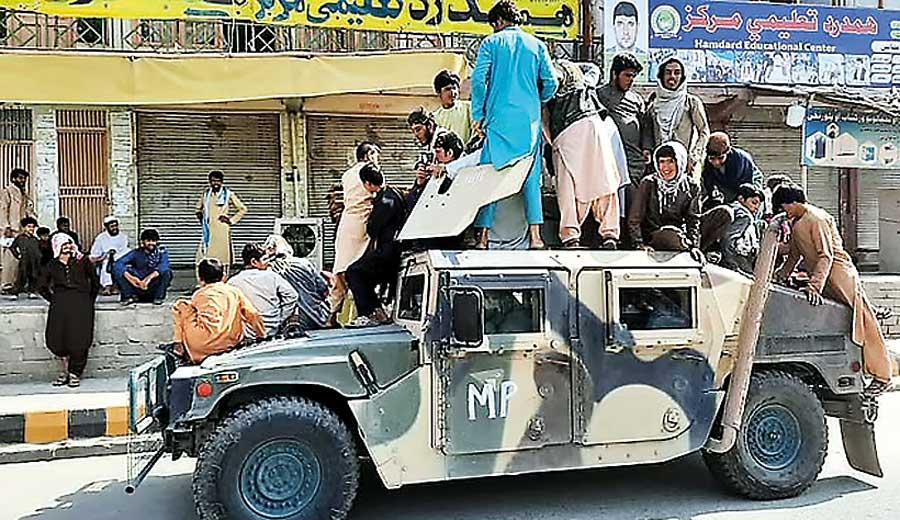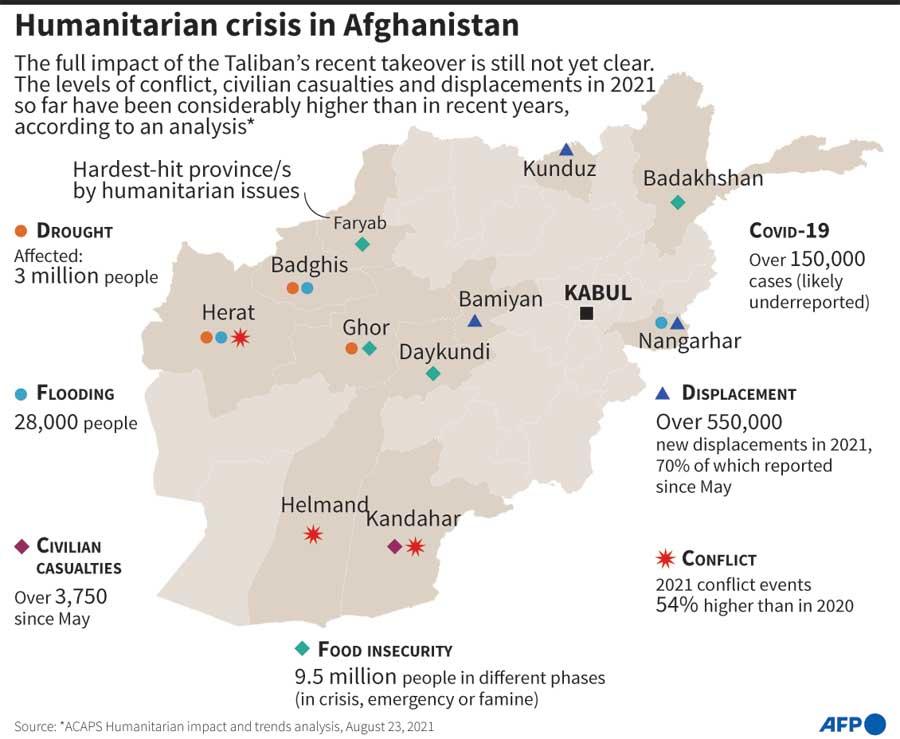Disaster capitalism booms while Afghanistan collapses in poverty

Taliban fighters sit on an Afghan army Humvee. Much of the equipment the US has given Afghanistan has 'fallen into the hands of the Taliban,' according to a US official. AFP
27 August 2021
Behind the frantic efforts by the United States to evacuate tens of thousands of foreign troops and Afghans before the Taliban’s no-nonsense August 31 deadline, lies a home truth of which little is spoken about in the US media. Heart-rending may be the scenes and the stories of those Afghans who are trying to find some squatting space inside a US cargo plane that will take them to the West. But there is also a little discussed story.
When interviewed by Western media channels, fear of the Taliban is the reason most Afghans
cite to explain why they want to leave behind their kith and kin and whatever they possess and leave for a nation where their fundamental rights they think will be guaranteed and where their girl children will get education and be respected as equal members of society. The explanation needs no further elaboration.
But Afghan analysts who are avoided by the Western media say economic reasons are also driving the Afghans to undertake the dangerous journey to the Kabul airport, braving Taliban checkpoints and gunfire.
The scenes of people clinging to aircraft on the tarmac will be the same in an airport of any crisis-ridden developing country if the people are allowed to leave for Western countries without tickets and without visas in cargo planes. For instance, if Sri Lankans are told they could go to America in US military cargo planes without tickets and visas, there would be many deaths due to the stampede at the Colombo airport.
The rarely discussed story behind the pathetic scenes at the airport stems from the question as to what happened to the trillion dollars the United States has spent during the past 20 years for its Afghan campaign. If the mission was to kill al-Qaeda leader Osama bin Laden and his followers for attacking America on September 11, 2001, the task could have been accomplished with intelligence gathering, precision bombing, a little bit of patience and an element of surprise. But it is disastrously ridiculous when nearly two trillion dollars was spent for 20 long years in Afghanistan only to restore the status quo that existed prior to the US invasion in October 2001 in the aftermath of the 9/11 attacks.
If only some of dollars from the mountain size money bag had been diverted to develop Afghanistan’s socio-economic infrastructure, enabling the people to improve their living standards, the Taliban would have found it difficult to make a comeback and the people would not have rushed to the airport to escape the Taliban horror. The occupiers and their puppet regime miserably failed in this regard.
According to World Bank statistics, Afghanistan’s GDP per capita income is a dismal US$ 508, making it the world’s seventh poorest country. With Sri Lanka’s GDP per capita being US$ 3,682, the average Sri Lankan, to put it simply, is seven times richer than the average Afghan.
The US through its aid agency USAID did strengthen institutions to promote education among Afghan children, especially girls. When the US invaded Afghanistan in 2001, only some 900,000 Afghan boys were going to schools as the Taliban had banned girls from going to school. But today, some 3 million Afghan boys and girls are receiving school education, according to USAID. A marked improvement indeed in a nation of 39 million people. But these programmes have little penetration in rural areas. Even after 20 years of the liberal West’s occupation, the literacy rate is a pathetic 43 percent in Afghanistan while half the population lives below the poverty line.
Besides, in the past two decades, Afghanistan has not seen new highways and mass scale industrial complexes that could encourage the Afghan youth to pursue education in the hope of gainfully employing themselves without being lured into the Taliban’s recruitment trap filled with ill-gotten money from the trade of narcotics which the Islamist militia has banned for consumpiton by Afghans but sanctimoniously permitted its smuggling.
The World Bank country report is also revealing. It highlights inadequate infrastructure, widespread corruption and an unusually large military expenditure as some of the factors that had impeded Afghanistan’s economic growth. The report says:
“Afghanistan’s economy is shaped by fragility and aid dependence. The private sector is extremely narrow, with employment concentrated in low-productivity agriculture. Private sector development and diversification is constrained by insecurity, political instability, weak institutions, inadequate infrastructure, widespread corruption, and a difficult business environment ... Grants continue to finance around 75 percent of public spending. Security expenditures (national security and police) are high at around 28 percent of GDP in 2019, compared to the low-income country average of around three percent of GDP, .... The illicit economy accounts for a significant share of production, exports, and employment, and includes opium production, smuggling, and illegal mining.”
The sorry state of the economy shows how little the country had benefited from the trillion dollars the US had pumped into the war-ravaged country. The money came from the US and went back to the US. The biggest benefactors are the arms dealers and the military contractors who supplied everything from pins to planes at inflated prices.
Of the trillions the US spent on the war on terror, some US$ 83 billion -- about US$ 4 billion a year -- had been spent to train and equip the 300,000-strong Afghan security forces. To the horror of the occupier, much of the overpriced military equipment is now in the Taliban possession after the Afghan security forces refused to fight the militia when the US troops started leaving.
Wherever the war on terror is waged, there is disaster capitalism, with the military industrial complex benefiting from the outcome. In Iraq, the second country to be invaded under the guise of the war on terror, ‘Destroy and Rebuild’ was the name of the game. Soon after the invasion, the US companies got the contracts to rebuild what the US military had destroyed. The contracts were funded largely from Iraq’s oil sales.
Afghanistan had no money or oil. This explains why there was little infrastructure development there. But this did not prevent the military industrial complex from making a killing.
The Afghan war was totally unwarranted and the US could have got rid of al-Qaeda through less costly means. But the nonconservative cabal which was influencing the US defence and foreign policy during the George W Bush presidency pushed for wars. A key part of the cabal was the arms industry. The military industrial complex and power politics as promoted by neoconservatism were a match made in hell.
As regards this demonic marriage, President Dwight Eisenhower, the only military general to become the US President, in his farewell speech in 1961, warned the American people to guard against its potential influence on policy matters.
But today, there is a third party in this unholy union -- the corporate media. No wonder the mainstream Western media are largely silent about the multibillion dollar profits made by the military industrial complex from wars in Afghanistan, Iraq and elsewhere in the guise of waging wars on terrorism.
 |

No comments:
Post a Comment
Note: only a member of this blog may post a comment.